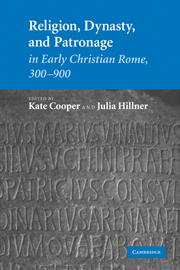Book contents
- Frontmatter
- Contents
- Acknowledgements
- List of contributors
- Abbreviations
- Introduction
- PART I ICONS OF AUTHORITY: POPE AND EMPEROR
- 1 From emperor to pope? Ceremonial, space, and authority at Rome from Constantine to Gregory the Great
- 2 Memory and authority in sixth-century Rome: the Liber Pontificalis and the Collectio Avellana
- PART II LAY, CLERICAL, AND ASCETIC CONTEXTS FOR THE ROMAN GESTA MARTYRUM
- PART III RELIGION, DYNASTY, AND PATRONAGE
- Bibliography
- Index
1 - From emperor to pope? Ceremonial, space, and authority at Rome from Constantine to Gregory the Great
Published online by Cambridge University Press: 02 October 2009
- Frontmatter
- Contents
- Acknowledgements
- List of contributors
- Abbreviations
- Introduction
- PART I ICONS OF AUTHORITY: POPE AND EMPEROR
- 1 From emperor to pope? Ceremonial, space, and authority at Rome from Constantine to Gregory the Great
- 2 Memory and authority in sixth-century Rome: the Liber Pontificalis and the Collectio Avellana
- PART II LAY, CLERICAL, AND ASCETIC CONTEXTS FOR THE ROMAN GESTA MARTYRUM
- PART III RELIGION, DYNASTY, AND PATRONAGE
- Bibliography
- Index
Summary
INTRODUCTION: DISCOURSES AND SOURCES
On 25 April 603 the Lateran basilica in Rome was the venue for a splendid ceremonial occasion. Rome's clergy and senate assembled there, together with the city's bishop, Pope Gregory the Great (590–604), for the reception of images, newly arrived from Constantinople, of the emperor Phocas (602–610) and his consort Leontia. The images were acclaimed in the basilica with chants of ‘Christ hear us! Long live Phocas Augustus and Leontia Augusta!’ After the gathering at the Lateran, Gregory oversaw the placing of the images in the chapel of St Caesarius within the old imperial palace on the Palatine hill. This striking episode is described in a document preserved in manuscripts of Gregory's Registrum. By the standards of our sources for early seventh-century Rome, it presents us with a very comprehensive account: it gives details not only of the date, location, and participants, but also of the ritual performed.
In an important respect, the events of 25 April 603 call into question some central assumptions about the history of the city of Rome in late antiquity. It is a feature of conventional descriptions of Rome in this period to stress how the place in society once occupied by emperor, senate, and imperial officials was taken over by the pope and the Roman clergy. This transformation from one dispensation to another is often regarded as having been mirrored by other shifts, most obviously in the city's religious profile, but also in terms of its physical fabric.
- Type
- Chapter
- Information
- Publisher: Cambridge University PressPrint publication year: 2007
- 35
- Cited by



